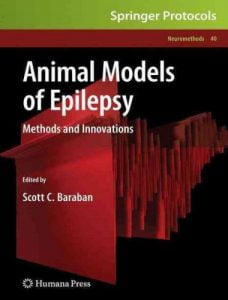Animal Models of Epilepsy Methods and Innovations, In this book, investigators examine several novel models of
 epilepsy in mice as well as in genetically tractable “simple” species. This is an ideal guide for scientists who wish to expand our understanding of the pathogenesis of this neurological disorder.
epilepsy in mice as well as in genetically tractable “simple” species. This is an ideal guide for scientists who wish to expand our understanding of the pathogenesis of this neurological disorder.
As a clinical epileptologist interested in fundamental aspects of epilepsy, I obtained a thorough update on the several frontiers of current epilepsy research from this lucid volume. Basic scientists will profit from these 14 distinct and succinct reviews that also treat methodology and pitfalls in detail. Thus, this work is recommended for basic science and clinical epileptologists as well as students of these disciplines.
Epilepsy is fairly unique among the various neurological disorders as it provides the neuroscientist with almost boundless opportunities to examine basic neurobiological mechanisms. Not surprisingly, advances in epilepsy research are closely tied to development of innovative neurobiological methodologies. In many cases the practical application of these innovations – especially in the context of a neurological disorder with anatomical, molecular, electrophysiological, and behavioral components such as epilepsy – can be found in the development of new animal models. In turn, our understanding of the pathogenesis of epilepsy (and new therapy development) greatly benefits from these models. Taking advantage of transgenic and homologous recombination techniques, laboratories have recently moved beyond the standard convulsant or stimulation models in rat to develop novel mouse models of epilepsy.
With contributions from prominent investigators in this field, this book provides a review of these emerging animal models of epilepsy. Prior textbooks devoted to models of seizure and epilepsy almost exclusively categorized rat models with little attention paid to these more innovative approaches. Here we attempt to diverge from the conventional epilepsy literature and focus on animal models that attempt to incorporate the latest technological advancements in neurobiology.
While some of these models and approaches are, admittedly, at very early stages of development and may ultimately fall short of widespread utilization, it is through the consideration and presentation of these models that the authors’ hope to advance and challenge the field of epilepsy research. Here we also attempt to move beyond a strict review of animal models and also include innovative approaches to epilepsy research that are just now appearing in the literature. These range from modeling seizure activity in silica to advanced strategies for seizure detection and gene therapy. These latter innovations are important as some may lead to better therapeutic treatments for patients suffering from intractable forms of epilepsy.
Password: pdflibrary.net
